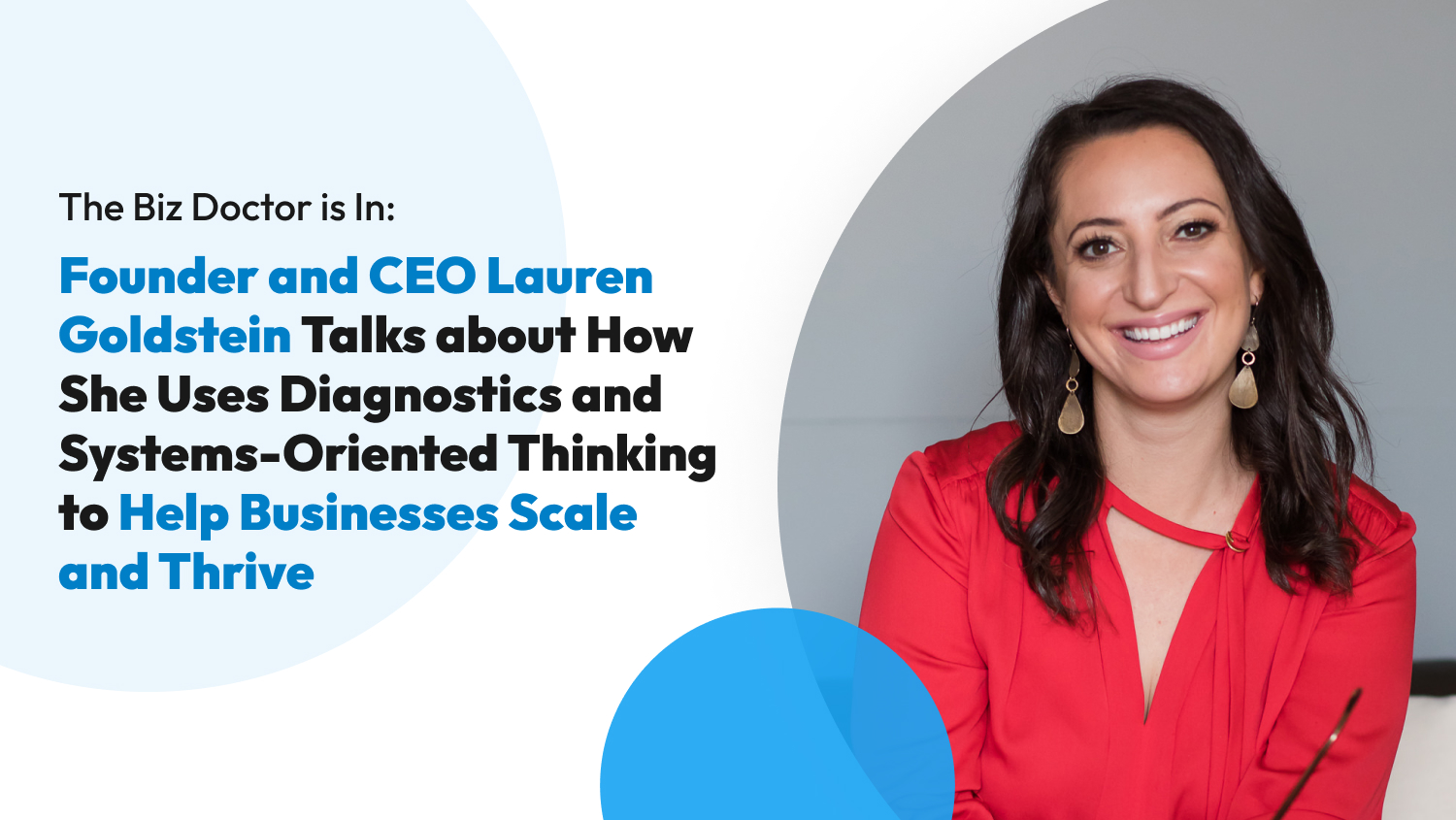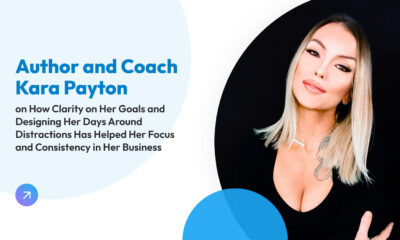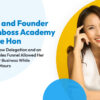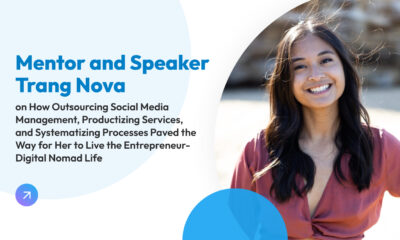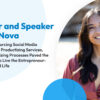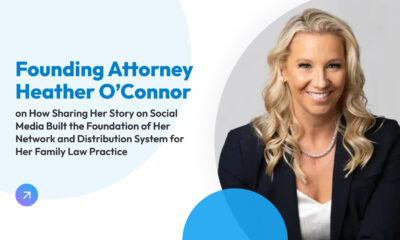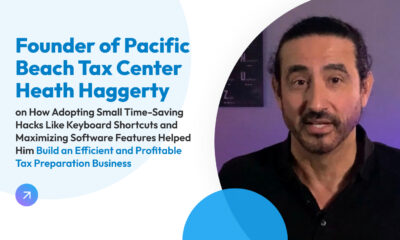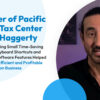Case Study
The Biz Doctor is In: Founder and CEO Lauren Goldstein Talks about How She Uses Diagnostics and Systems-Oriented Thinking to Help Businesses Scale and Thrive
Lauren Goldstein had her whole life planned out. She was fully committed to pursuing a medical degree and had worked for almost ten years in hospitals as an EMT and as a pediatric neurology, and epilepsy researcher. But when she began to see how much influence insurance companies had over patient care compared to the actual medical doctors, she got disillusioned and ultimately decided to leave the medical field.
In the midst of this career crisis for the self-confessed (recovering) perfectionist, she found encouragement to try out a different discipline, one she was barely familiar with.
In this article, we learn about Goldstein’s shift from medicine to consultancy and the challenges she overcame at different stages of her business’ growth. She shares the tools she uses and some great reads, so don’t forget to check out her Productivity Stack Quick Reference and Reading List at the end.
Table of Contents
- Starting
- Growing
- Scaling and Success
- Other recommended tools
- Hindsight: What Goldstein would have done earlier or differently
- Wrap Up
- Goldstein’s Read List
- Goldstein’s Productivity Stack Quick Reference
- More about Lauren Goldstein
Starting
Challenge 1: Starting a consultancy from scratch
Goldstein quit her dreams of becoming a doctor without a plan B, and she struggled to find what to do next. She worked part-time in their family business, read many books, and found a mentor through the synagogue and her Jewish community.
Her mentor told her, “I think you should be a consultant. The way that your brain solves problems, just like when you were diagnosing tiny humans, is perfect for business because they need that outside perspective. They need that ability to look at all the moving pieces and see what’s not working and what is working.”
Although unsure, she followed her mentor’s advice and founded Golden Key Partnership Business Consulting Services. She felt lost and completely out of her depth, having no formal training or experience in the field. She recalls, “I had a lot of imposter syndrome because I’d never done this before, and I was advising companies on things [that I didn’t have experience in] like I’d never built a million-dollar business!”
Solution: Her background in cognitive neuroscience helped with the psychology and mindset side of business consulting. And she worked very hard, studying as she worked alongside her first clients, always trying to stay one step ahead of them.
In this learning phase, she said “yes” to anything her clients asked. This helped her build a broad understanding of business challenges, and fortunately, her clients found her services valuable enough to send referrals her way.
“I had really great clients and word-of-mouth started to really pick up, and I kind of never looked back. But that first year – wow. It was a lot.”
People: Goldstein, her mentor
Systems: Working with a mentor, saying “yes” to all opportunities, learning on the job, offering more generalist services while starting out
Challenge 2: Finding her niche
Because her general business consulting service was so broad in scope, Goldstein reached a point where she felt she was spreading herself too thin. She shares, “I was a mile wide and an inch deep.”
She took the Wealth Dynamics Entrepreneur Profiling Assessment to better understand her strengths and weaknesses. “I figured out what my profile was, which is a mechanic. That means that I can bridge the ‘what’ all the way to completion to ‘how,’ which is a very rare trait. I realized how valuable my skill set was and how much of a disservice I was doing to people by not actually diving in deeper and just focusing on a few things.”
Solution: Goldstein started paying attention to what areas she was good at and what she enjoyed doing. She purposefully cut out anything others could do better and what she didn’t get fired up by. She sat on research boards that helped develop Kajabi, Calendly, Typeform, and MailChimp for business use.
She tells us, “When I look back at the things that I was really good at and enjoyed, it was all related to operations and teams, which is where my sole focus is now. The way my brain works is it sees all the moving parts and then exactly how they connect together. So it was a pretty easy transition for me to go to operations and system work.”
She took time to understand her ideal client as well. She began to see that start-ups, tech or otherwise, were not a great fit. She wanted to work with successful service-based businesses looking to scale up.
And it turned out, niching down in terms of her service and her target market made it easier to find new leads. She recalls, “I started to get known for just a few things, which made me more referable, which helped with word-of-mouth.”
People: Goldstein
Systems: Examining what niches she excels at and loves to do, saying no to opportunities not aligned with her niche
Growing
Challenge 3: Vetting potential clients
With clarity on her niche and ideal client, Goldstein needed to be selective with new prospects who approached her. She points out, “Just because somebody wants to work with you, doesn’t mean they’re a good client for you. There are businesses out there that I know I can help, but if the business owner isn’t in the right frame of mind with how they want to scale their business and get out from underneath it, then it’s not going to be as successful as it could be.”
Solution: She built a pre-qualifying questionnaire in Calendly for anyone seeking a consultation. She collects some general information, such as their most pressing operational challenges, average yearly revenue, and team size. Then, she sets an hour-long consultation call which she treats like a first date. Both she and the potential client can make an assessment of their fit for each other.
People: Goldstein
Systems: Thorough vetting process to ensure a good fit between her and potential clients
Challenge 4: Distribution: Peaks and valleys from word-of-mouth marketing
Goldstein managed to grow her business on a passive method of lead generation. She still relies primarily on word-of-mouth and referrals. But she knows firsthand this is not a reliable way to build a healthy pipeline of new businesses.
She emphasizes, “Don’t just build your business on word-of-mouth. It creates peaks and valleys that are not fun.”
Solution: Now, she has more outward-facing marketing strategies. She is using email marketing, and launched ‘The Biz Doctor Podcast’ in April 2022 to reach a wider audience.
In addition, she has learned to network with individuals in ‘adjacent businesses.’ She has found that being in contact with people who are part of the same professional or business circles that are her target market has made it easier to find warm leads.
She explains, “I actually partner with people who do similar things in business, but adjacent. So a lot of my partnerships are with Chief Marketing Officers or Chief Finance Officers. They’re in that same sea of people, but they see different aspects of the business than I see. It’s a really great synergy because it’s like I had stopped digging in the desert [for water] and rather looked for where there was already flow and plugged in there. It takes a lot less work to plug into people that are already serving those that you want to serve.”
People: Goldstein
Systems: Outward-facing marketing, networking, and partnering with adjacent businesses
Tools: Drip, podcast equipment, LinkedIn
Challenge 5: Managing workload as a solopreneur
Goldstein offers several different service packages, from diagnostics to consulting and fractional COO work. The length of engagement and depth of involvement is varied, so how does she handle all the workload as the sole operator of Golden Key Partnership?
Solution: Every year, she asks herself how else she can simplify the business. Apart from saying “no” to a lot of asks that don’t align with her niche and market, she has also simplified her business consulting and advisory framework.
She describes the different services or packages like a ‘yellow brick road’ or navigational guideposts. They provide a set process to diagnose and address operations and team issues within a client’s business. This set process guides her approach but gives her enough flexibility for each case as needed.
In addition to streamlining her approach, she also sets a cap on the number of clients per type of service. Goldstein knows businesses are very dynamic and so she builds space in her schedule to be hands-on with her clients. For example, for advisory services, she takes a maximum of eight clients a year; for fractional COO work, up to two clients a year; and diagnostics, up to four clients a month.
People: Goldstein
Systems: Matching client intake with service capacity
Scaling & Success
Challenge 6: Delegation: Worker bees vs. players
Goldstein has been building up her team for over five years now. Her first hire was an assistant who, unfortunately, was not the best fit for the role. Goldstein found herself picking up the slack on many tasks.
Solution: She learned the difference between ‘worker bees’ and ‘players’ and to hire more of the latter. Worker bees need more support and guidance, while players are more proactive and independent workers looking to forward the business. Today, she has an administrative assistant and a marketing assistant who provide her with that ‘player’ type of support that eases her load in running the business.
This experience in building a team has also taught her to shift focus from “What is this going to cost me?” to “What is this going to make me?” She shares, “I was a little nervous about adding expenses when our income in those first few years wasn’t very consistent. What I realized through my work and in building teams is that I could have a part-time player who I pay good money to, but that is more effective than a full-time person. I’m a big proponent of ‘if you don’t need somebody full-time, don’t hire them full-time.’”
People: Goldstein, administrative and marketing assistants
Systems: Hiring ‘player’ team members, hiring part-time team members as needed
Challenge 7: On the verge of burnout
In spite of simplifying her business and getting a support team on board, Goldstein still reached a point where she almost burnt out about five years ago.
She recalls, “We were having record-breaking growth, record-breaking months. I had just said ‘yes’ to too many things, and we were at capacity. I remember sitting at my desk on a Friday crying and thinking, ‘I don’t think I can hold this together. I’m letting myself down, I’m letting my team down, and worst of all, I’m letting my clients down.’”
Solution: That same Friday night, when she was close to having a breakdown, she closed her laptop, went to bed early, and completely unplugged from work until the end of Saturday. She found herself refreshed and ready to work again with a new perspective by Sunday.
Since then, she has developed a way to protect her mental health and her time. She sets theme days as follows: Mondays for meetings, Tuesdays and Thursdays for client consultations and diagnostics, Wednesdays are admin days, and Fridays are flexible, where she can work on financials or squeeze in client work that couldn’t find a Tuesday or Thursday schedule.
Saturdays and Sundays are dedicated solely to unplugging and doing everything unrelated to her business. By Sunday evening, she takes out a notepad to list down the ‘big three’ things she needs to get done in the week and then focuses on the one big thing that will move the needle for her business. She also uses the Eisenhower Matrix to tag those things she will do and what she can defer, delegate or delete.
She tells us about how the admin days help her work on moving the business forward, “I was doing so much client work that I would forget to work on my business and get new clients. And then I look up, and I go, ‘Oh, no, we need a client! Having admin days is an intentional way for me to keep the momentum.”
She also credits her Saturdays off for doubling her business. “I’m very efficient, super efficient. But if I’m not fully charged, it doesn’t matter how efficient I am. I’m still going to be on that verge of being exhausted or burning out.” A day solely for recharging has been a game-changer for her.
People: Goldstein
Systems: Setting theme days, focusing on three tasks and one major task for the week, using the Eisenhower Matrix of do, defer, delegate, and delete
Tools: Google Calendar, notepad
Other recommended tools
Goldstein gave us a comprehensive rundown of her technology stack:
- WordPress for the website
- Streak as their customer relationship management tool
- Google Workspace
- Thrivecart and Stripe for purchases and payments
- Dropbox Sign for signed contracts
- Typeform for client intake, midway check-in, and post-project evaluation forms
- Zapier to connect all the tools
- ClickUp for project management
- Slack for messaging
- Teamwork project management tool for developers
- Kajabi for workshops and video lessons
Hindsight: What Goldstein would have done earlier or differently
Goldstein highlights two things she would have done earlier. The first is to have hired additional staff or team members earlier, even on a part-time basis.
Secondly, she thinks she should have networked and joined communities of other businesses earlier. She has found it helpful to be around companies that have achieved what she was striving for. But also, as she mentioned when we talked about the peaks and valleys of word-of-mouth marketing, she has found great partnerships and new business leads in networking with ‘adjacent businesses.’
Wrap Up
Goldstein’s story is somewhat unique in how wide the gap was between her career and what she pursued as a business. The transition from EMT, hospital, and medical research to business advisory and consultancy is not a very obvious or easy one!
She fearlessly jumped into a new arena and hustled non-stop up a steep learning curve in order to provide solutions for her clients. But it is a great example of how core skills, like systems thinking, diagnostics, and research can be transferable between seemingly unrelated fields. And while her starting point may have been unusual, her entrepreneurial journey faced the same fundamental challenges of finding a niche, marketing, hiring, systematizing processes, avoiding burnout, and scaling.
Her strategy of partnering with ‘adjacent businesses’ is a great approach that can make for more productive networking efforts as we learn to look at less obvious opportunities. She also told us about how working at high efficiency is only possible with built-in rest, time, and energy management systems that she adheres to consistently week after week.
The Biz Doctor is on a mission to give successful businesses that extra boost to get to the next level. Aside from the podcast, Goldstein’s Golden Key Partnership has launched a new service on ‘done-for-you’ hiring. To get a feel for her style and approach to business consulting, feel free to check out the free resources and helpful tools on her website!
Goldstein’s Read List
- The ONE Thing: The Surprisingly Simple Truth About Extraordinary Results by Gary W. Keller and Jay Papasan
- Thinking in Bets by Annie Duke for a great read on decision-making. The author talks about “resulting” and “hindsight bias,” the former judging the quality of a decision based on the outcome and the latter accepting particular outcomes as inevitable. Both ways of evaluating a decision could be flawed because of incomplete information we have at any given time. Goldstein shares how this kind of thinking can be paralyzing to an entrepreneur who is afraid to make the “wrong decisions” based on what has happened before.
- Deep Work by Cal Newport
- The Four Agreements by Don Miguel Ruiz
- Traction: Get a Grip on Your Business by Gino Wickman
Goldstein’s Productivity Stack Quick Reference
Starting
Growing
Scaling and Success
- Upwork
- Indeed
- Google Calendar
- Notepad
- WordPress
- Google Workspace
- Thrivecart
- Stripe
- Dropbox Sign
- Typeform
- Zapier
- ClickUp
- Slack
- Teamwork
- Kajabi
More about Lauren Goldstein
Lauren Goldstein is the founder and CEO of the award-winning and globally-recognized business consulting firm, Golden Key Partnership.
Her clients lovingly call her “The Biz Doctor” (which also happens to be the name of her podcast). Her superpower is helping 7-figure service-based entrepreneurs uncover what is keeping them stuck in the trenches of their businesses so that they can have more freedom, impact, success, happier teams, and can breathe a much-needed sigh of relief.
She’s been featured in Thrive Global, HuffPost, and Authority Magazine and is a trusted expert to Fortune 500 companies like Apple, Nike, and AT&T, among others.
For more from Lauren and to learn more about her signature diagnostic framework, tune in to her podcast, The Biz Doctor, available on all platforms, or visit her website: https://www.GoldenKeyPartnership.com
Grab her Golden Key Scorecard Here
Use her affiliate link to get an extended 30-day trial deal for Kajabi here
You can also get in touch via:
Instagram: https://www.instagram.com/itslaurengoldstein/


